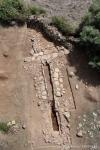Summary (English)
The “Tomb of the Sword” or Tomb 1, is situated at 200 m south-east of the Arrubiu di Orroli nuraghe and was the necropolis of the community that settled there during the most flourishing period of the nuraghe: the Recent Bronze Age (late 14th-13th century B.C.). The excavations revealed a monument c. 14 m long and c. 6 m wide. The nuraghe was disturbed during the Roman period and its extrados built in Greek-style opus quadratum was completely robbed out. Indeed, the skeletal remains of the collective burial were scattered and no longer articulated. However, a preliminary study has shown that individuals of all ages and sexes were buried there. Grave goods, dating exclusively to the nuragic Recent Bronze Age, were recovered from the complex stratigraphy that was heavily damaged in the 1960s.
Among these were four grey pottery bowls with internal offset, a small jar with neck, two deer antlers made of small bronze, a complete votive sword and one in two small fragments, a bronze punch and about 300 glass paste and faiance beads that have well-documented parallels in the Mediterranean, especially the Ulu Burun wreck. Among the plant remains recovered from the sieving there was a carbonised grape pip Vitis vinifera, probably of the wild subspecies. Biochemical analyses were undertaken on two of the vases from the tomb, which revealed their contents. The small four-handled jar had contained tartaric acid, therefore wine, and there was no trace of syringic acid deriving from the breakdown of malvidin (a natural pigment giving red grapes their colour). Therefore, this was white wine, moreover very sugary, to date the earliest known in the Western Mediterranean. A small grey pottery bowl, a sort of ‘wine taster’, was used to drink milk and white wine.
- Fulvia Lo Schiavo - Direttore Museo "Sa Domu 'e su Nuraxi Arrubiu" - Orroli
- Mauro Perra - Civico Museo “Genna Maria”, Villanovaforru
Director
Team
- Philippe Marinval
- Ornella Fonzo
- Nicolas Garnier - Laboratoire Nicolas Garnier (FR)
Research Body
- CNRS (FR)
- Museo di Orroli
- Museo di Villanovaforru
Funding Body
- Comune di Orroli






![Download [PDF]](/excavation/skins/fasti/images/results/download_sml.png)
